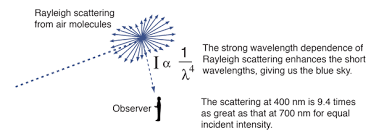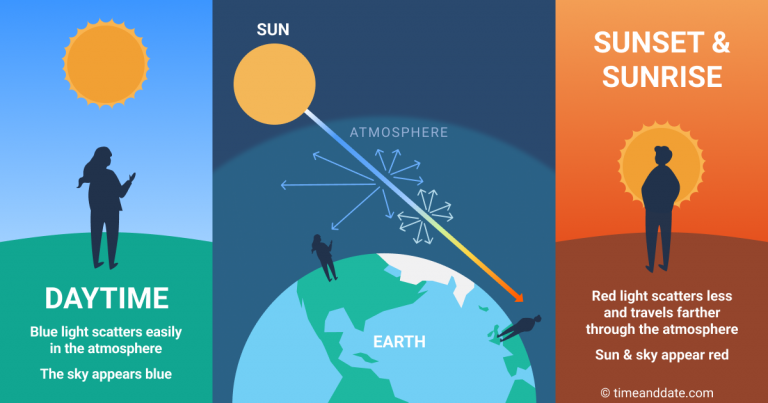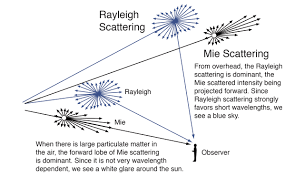Why is the sky blue? What is Rayleigh scattering?

Rayleigh Scattering: Illuminating the Secrets of the Sky
Introduction: The vibrant blue color of the sky has captivated humanity for centuries, evoking a sense of wonder and curiosity. This phenomenon can be attributed to Rayleigh scattering, a fundamental process that shapes the colors we observe in the atmosphere. In this blog post, we will delve into the intricate world of Rayleigh scattering, exploring its principles, significance, and impact on our everyday lives.
Understanding Rayleigh Scattering: Rayleigh scattering is a phenomenon in which the interaction of light with particles or molecules in the atmosphere causes the scattering of shorter wavelengths of light more than longer wavelengths. Named after the British physicist Lord Rayleigh, who first described it in the late 19th century, Rayleigh scattering primarily affects sunlight as it enters the Earth’s atmosphere.
The Science Behind the Blue Sky: To understand why the sky appears blue, we need to examine the nature of sunlight. Sunlight consists of various colors, ranging from red to violet, which form a spectrum known as white light. This light is composed of photons, which are particles that carry energy. When sunlight enters the Earth’s atmosphere, it interacts with molecules such as oxygen and nitrogen.
The molecules in the atmosphere are much smaller than the wavelength of visible light, making them ideal candidates for Rayleigh scattering. As the photons interact with these molecules, they are scattered in all directions. However, shorter wavelengths (blue and violet) experience a higher degree of scattering compared to longer wavelengths (red and orange).
The key factor at play here is the relationship between the wavelength of light and the size of the scattering particles. The wavelength of blue light is relatively short, making it more susceptible to scattering by the smaller molecules in the atmosphere. In contrast, red light has a longer wavelength, which leads to less scattering.
The Path of Scattered Light: As sunlight travels through the atmosphere, the blue and violet light waves are scattered in every direction. This phenomenon causes the blue light to reach our eyes from all regions of the sky, resulting in an overall perception of a blue sky during daylight hours. The scattered blue light dominates the sky, overpowering the scattered light of other colors.
The Role of Atmospheric Conditions: Various factors influence the intensity and appearance of Rayleigh scattering. The density of molecules in the atmosphere, the angle at which sunlight enters the atmosphere, and the amount of dust, pollutants, and water vapor present can all impact the scattering process. For example, when the atmosphere contains more particles, such as during pollution episodes or volcanic eruptions, the sky may appear hazy or reddish.
Beyond the Blue: Rayleigh scattering not only explains the blue color of the sky but also affects the colors of other celestial phenomena. During sunrise or sunset, the sun’s light has to pass through a larger portion of the atmosphere. This path lengthens the scattering process, resulting in longer wavelengths (red and orange) dominating our field of view, thus giving rise to the warm hues we associate with these times of day.
Applications and Implications: While Rayleigh scattering is primarily responsible for the colors we perceive in the sky, it has broader implications in various scientific fields. Understanding the scattering of light is crucial for atmospheric scientists studying climate change, as it influences the transmission of solar radiation, the behavior of sunlight in the atmosphere, and the distribution of energy across the Earth’s surface.
Moreover, Rayleigh scattering plays a vital role in the field of astronomy. Scientists use this scattering effect to study celestial objects such as stars and planets. By analyzing the scattering of starlight, astronomers can determine the composition of distant celestial bodies and gain insights into their atmospheres.
Conclusion: Rayleigh scattering unveils the fascinating science behind the colors we observe in the sky. From the mesmerizing blue hues of a clear day to the captivating shades of sunrise and sunset, this scattering phenomenon holds the key to understanding our atmospheric environment. By unraveling the mysteries of Rayleigh scattering, scientists continue to deepen their knowledge of Earth’s atmosphere and the vast universe beyond.
Sunlight reaches Earth’s atmosphere and is scattered in all directions by all the gases and particles in the air. Blue light is scattered more than the other colors because it travels as shorter, smaller waves. This is why we see a blue sky most of the time.
Which reason sky is blue?
What is the real color of the sky?
Why is the sky blue while clouds are white?





Read next

What does it mean to have white eyes?

What the COVID-19 epidemic could mean for electronic health records?
